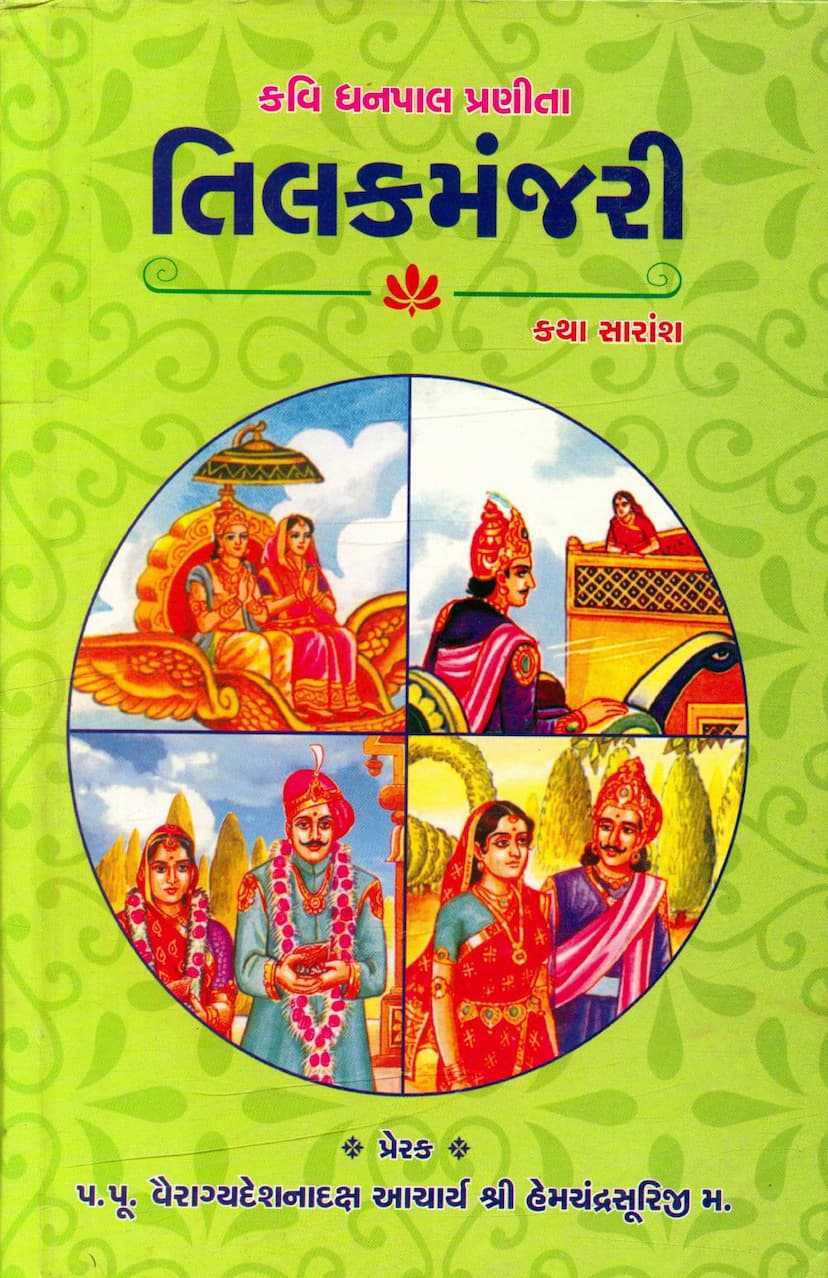Tilakmanjari Katha Saransh
Added to library: September 2, 2025

Summary
Here's a comprehensive summary of the provided Jain text, "Tilakmanjari Katha Saransh," based on the scanned pages:
The document is a summary of the "Tilakmanjari," a literary work by the great poet Dhanpal. The summary has been prepared by Prabhudas Bechardas Parekh, with guidance and inspiration from Acharya Shri Hemchandrasuriji M. and Acharya Shri Jayghoshsuriji M. The publisher is Shri Jinshasan Aradhana Trust. The work is dedicated to the memory of Pu. Gurudevshri Vijaybhuvanbhanusurishwarji Maharaja.
Key Aspects and Content:
-
Author and Work:
- The original work, "Tilakmanjari," is by the renowned Jain poet Dhanpal.
- Dhanpal was a highly learned and respected scholar and poet, known for his mastery of Sanskrit and Jain scriptures. He was also a devout Jain.
- The summary aims to present the essence of the descriptive narrative of "Tilakmanjari."
-
Inspiration and Guidance:
- The summary is dedicated to the gurus like Acharya Shri Hemchandrasuriji M., Acharya Shri Jayghoshsuriji M., and Acharya Shri Vijaybhuvanbhanusurishwarji M. Their guidance and inspiration have been crucial in bringing this work to fruition.
- The publication is part of the ongoing efforts by Shri Jinshasan Aradhana Trust to revive and re-publish valuable Jain literature, having successfully revived around 350 texts.
-
Historical Context of "Tilakmanjari":
- Dhanpal composed "Tilakmanjari" about 300 years after Banabhatta's "Kadambari."
- It is considered a significant prose-poem that rivals or even surpasses "Kadambari" in certain aspects, though it is less known among contemporary scholars.
- The work was commissioned by King Bhoj, a close friend of Dhanpal.
- The original "Tilakmanjari" was reportedly 12,000 verses long.
- The text highlights the significant contribution of scholars like Pandit Sukhulbhai who helped in purifying and making the original texts accessible.
-
Dhanpal's Life and Conversion:
- The summary includes details about Dhanpal's lineage as a Brahmin scholar named Devrishi.
- Dhanpal's brother, Shobhan, became a Jain monk under Acharya Mahendrasuri, which led to a conflict with their father, Sarvadev, regarding a vow. Dhanpal, initially hesitant due to his Vedic upbringing and association with King Bhoj, eventually embraced Jainism after a profound encounter with Jain monks and their teachings, particularly concerning karma and righteous conduct.
- The text details Dhanpal's intellectual prowess, his engagement in poetic debates with King Bhoj, and his eventual deep involvement with Jain philosophy.
- A significant event mentioned is the burning of Dhanpal's original "Tilakmanjari" by King Bhoj due to Dhanpal's refusal to alter the narrative to align with Vedic traditions. However, the story also recounts how Dhanpal's daughter helped him reconstruct the text, demonstrating the importance of knowledge and memory.
-
Narrative of "Tilakmanjari" (Summary of the Katha):
- Characters: The main characters are King Meghavahan of Ayodhya, his devoted wife Madiravati, Prince Harivahan, and the principal heroine Tilakmanjari, daughter of King Chakrasen of Rathnoopur. Samarketu and Malay Sundari are important secondary characters whose story is interwoven.
- Plot Points:
- King Meghavahan and Queen Madiravati are childless, leading to their deep sorrow. They receive divine guidance and a mantra from a Muni to worship the goddess Parthivakula, promising a virtuous son.
- Prince Harivahan is born, exhibiting remarkable qualities.
- A significant event involves a minister's attempt to find a suitable companion for Harivahan, leading to the introduction of the story of Tilakmanjari, who is revealed to be the daughter of a Vidhyadhar king and destined to marry Harivahan.
- The narrative includes the epic journey of Harivahan and Samarketu, their adventures, encounters with supernatural beings (like Vetals and divine beings), the magical properties of divine artifacts (like the Chandrap ring and necklace), and their eventual reunion and marriages.
- The story is rich in descriptions of nature, cities, palaces, and the celestial realms.
- It emphasizes Jain principles such as karma, rebirth, righteousness, non-violence, and the pursuit of spiritual liberation through learned conduct and devotion.
- The story incorporates elements of fate, divine intervention, and the consequences of past actions.
- Literary Style: The "Tilakmanjari" is praised for its elegant prose, beautiful descriptions, judicious use of poetry at appropriate moments, and its balanced approach, avoiding the excessive complexity of "Kadambari" or the over-reliance on poetry found in other works. It is presented as a "novel" in Sanskrit literature, unique in its style and narrative.
-
Key Themes:
- The power of love and destiny.
- The consequences of actions (karma).
- The pursuit of spiritual knowledge and liberation.
- The importance of righteousness and virtue.
- The blend of human and divine elements in life.
-
Other Works by Dhanpal:
- The document lists "Rishabh Panchashika" (Prakrit praise of Rishabhdev) and "Paiyalachchhi Namamala" (a Prakrit word dictionary).
- It also mentions potential works like a commentary on Shobhan's stuti and a stuti dedicated to Mahavir Swami in Sachor.
-
Critique and Significance:
- The summary highlights the literary merit of "Tilakmanjari" in its balance of prose and poetry, its vivid descriptions, and its philosophical depth, particularly its adherence to Jain principles.
- It laments the lack of widespread recognition for Dhanpal's work in modern times and suggests its potential as a substitute for "Kadambari" in Sanskrit studies.
- The publisher's note also touches upon the importance of reviving such ancient Jain literature for the benefit of society and promoting Jain knowledge.
This summary provides a comprehensive overview of the provided pages, capturing the essence of the literary work, its author's life, the narrative arc, and its significance within Jain literature.